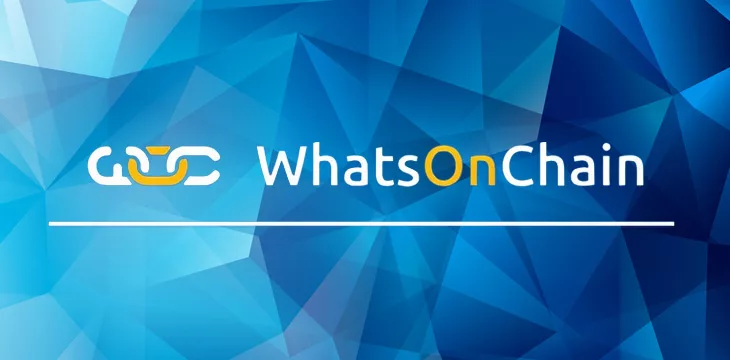|
Getting your Trinity Audio player ready...
|
BSV blockchain explorer WhatsOnChain (WoC) is working to make life easier for app developers by adding new features like APIs to check the current state of unspent transaction outputs (UTXOs) directly. Additionally, the team has sparked new interest by allowing app developers to write their own plugins that appear on the WoC site and are available for anyone.
Among the most popular additions is a BSV-20 plugin from sCrypt, which “decodes” the token data and presents its contents in a user-friendly way.
Blockchain wallets can seem deceptively simple to end users, but there’s always much more behind the scenes. Rather than constantly scanning the entire blockchain for new information (which would slow things down to impossible levels), they need to make specific queries about addresses and UTXOs their users are using.
In the past, ElectrumX had the most comprehensive set of UTXOs, and many developers have come to rely on those sets to check data like wallet balance and history, network activity, congestion, etc. However, WhatsOnChain saw a need for UTXO sets and APIs that were updated more regularly and were better able to cope with the BSV network’s growth. Any developers currently using ElectrumX should check out WoC’s new features.
Tags on the WoC site show whether a transaction output has subsequently been “spent” or remains unspent. Miners only care about unspent transactions, but even spent ones may have additional data that can be decoded and visualized somehow. WoC tags also indicate which application protocol a transaction output is used and if more data on that output is available.
Plugins show protocol specifics, statistics
Application developers would also like to see stats on the protocols they created and track transactions specifically related to those protocols. Non-developer, casual viewers of blockchain data (e.g., researchers and reporters) can view statistics on how popular a particular protocol is at any given time. Need to know how many BSV-20 token transactions have taken place in the past week, and how they compare to other token protocols? That information is now available.
🚀 Launching the (un)spent API! 🚀https://t.co/ln8K5p4lhc
Check where your transaction output was spent, or get more info on your UTXOs 🧐
We've also added spent indicators on the website: https://t.co/1xKNSybhmA pic.twitter.com/TJcEidyFwJ
— WhatsOnChain (@WhatsOnChain) October 26, 2023
CoinGeek spoke to WhatsOnChain Product Manager Matija Hanzevacki about the new features. He noted that The UTXO endpoints are aimed at developers to support various use cases, the most popular being wallet applications. A blockchain wallet needs to keep its state updated for each address in its records, including data like balance and history, to keep everything fast and secure.
Now you can view BSV20 token transactions at WhatsOnChain using our plugin https://t.co/S9loUsjhqz pic.twitter.com/TkfNEFDSI9
— sCrypt Official | OP_CAT 🐱 (@scryptplatform) December 13, 2023
“This plugin is fully owned by sCrypt, and we do not control what is displayed. This enables developers from the community to extend the capabilities of WhatsOnChain, by not blocking on us, but rather themselves developing these plugins.”
Allowing app/protocol developers to create their own plugins also gives them greater control over the information they can view on WhatsOnChain without having to request WoC’s team to create specific features for them.
sCrypt’s BSV-20 plugin will display whether or not a token is validated/verified or pending, as well as the amount of BSV-20 tokens held by a particular UTXO. If from a P2PKH transaction, it shows the owner’s Bitcoin address. The token’s operation (in BSV-20 terms) is also there—useful to see where a token was first deployed/minted and showing a “non-BSV20 input.”
There are currently eight plugins available for WhatsOnChain, reflecting the various use cases for the BSV blockchain and giving users an interface to view a transaction’s app/protocol data in more detail. There’s also a template available on WoC’s GitHub.
- WOC Default Decoder
- Bico decoder
- 3D Model Viewer
- STAS Viewer
- Tokenized Protocol
- BMAP
- sCrypt
- BSV20
Decoders are available if a user clicks on a transaction output tagged as containing specific data the decoder can handle. The 3D Model Viewer is probably the most visually stimulating, with its ability to display 3D images that can be viewed from various angles.
WhatsOnChain is inviting other developers to submit their own plugins for the site. As well as making things more visual and user-friendly, a plugin increases overall trust in a protocol by decoding its data on a “neutral” platform (i.e., outside its home/proprietary app).
As use cases for putting data on an unbounded-scaling blockchain network increase, it becomes ever more important to have explorers and indexing services to find and validate information. For developers and their applications, it also means faster speeds as the code can verify transactions without keeping a complete record of the entire blockchain (BSV’s blockchain, as of December 2023, is almost 10TB in size) and/or searching the entire blockchain for a single transaction.
As well as WhatsOnChain’s API set for UTXOs, BSV also has JungleBus (from the GorillaPool team) and Bitails.
JungleBus has described the BSV blockchain as “a monolithic database” that can leave developers and users lost without some way to find specific information and make sense of it. Similar to early internet search engines, they exist to turn massive worldwide scaling into something more useful to everyone.
Watch: The only blockchain able to handle speed and volume is BSV

 07-11-2025
07-11-2025 





